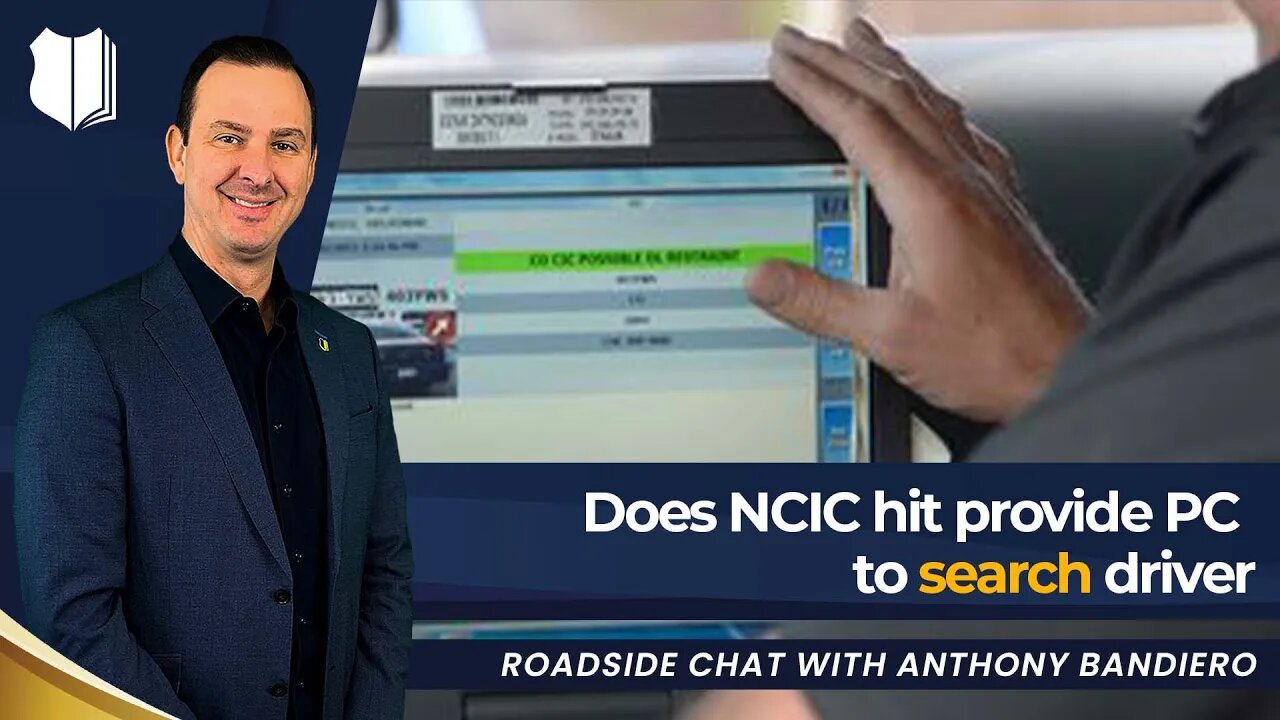Premium Only Content

Ep. #339: Does NCIC hit provide PC to search driver?
📌 There is a long line of cases from this and other circuits that an “NCIC hit,” although not definitive in terms of conviction, “has been routinely accepted in establishing probable cause for a valid arrest.” United States v. Hines, 564 F.2d 925, 927 (10th Cir.1977); see also Scull v. New Mexico, 236 F.3d 588, 599 (10th Cir.2000) (because the officials “believed they had the lawful authority to imprison [defendant] based on the NCIC hit,” defendant could not show that they “knew that they had no lawful authority” to imprison him for purposes of his false imprisonment claim); United States v. Munoz, 150 F.3d 401, 411–12 (5th Cir.1998) (concluding that officers' knowledge, through NCIC, of outstanding warrant, along with a reasonable belief that the defendant was in the apartment, “sanctioned going into the apartment” to arrest him), cert. denied, 525 U.S. 1112, 119 S.Ct. 887, 142 L.Ed.2d 786 (1999); Brooks v. George County, 84 F.3d 157, 167 n. 12 (5th Cir.1996) (noting that “NCIC printouts provide a reliable basis for probable cause to arrest”); United States v. Towne, 870 F.2d 880, 884 (2d Cir.1989) (finding probable cause to arrest where officer learned of out-of-state warrant after conducting a background check on NCIC, contacted out-of-state authorities to confirm warrant, and requested and received certified copy of warrant before arresting the defendant); United States v. Roper, 702 F.2d 984, 989 (11th Cir.1983) (finding probable cause to arrest where officer radioed NCIC and learned of warrant); United States v. McDonald, 606 F.2d 552, 553–54 (5th Cir.1979) (“While NCIC printouts are not alone sufficient [e]vidence to permit [c]onviction, the cases uniformly recognize that NCIC printouts are reliable enough to form the basis of the reasonable belief which is needed to establish probable cause for arrest.”) (footnote omitted); United States v. Davis, 568 F.2d 514, 516 (6th Cir.1978) (“An NCIC identification of a vehicle is sufficient to establish probable cause for the arrest of one possessing it....”); United States v. Palmer, 536 F.2d 1278, 1283 (9th Cir.1976) (concluding that probable cause existed for the defendant's arrest based on information obtained from NCIC and other evidence suggesting that the defendant was, in fact, the suspect identified on NCIC).
- Case v. Kitsap Cnty. Sheriff's Dep't, 249 F.3d 921, 928 (9th Cir. 2001)
-----
✅ Drop a like and subscribe, thank you for your support! 🥰
🚨 Do have another roadside chat question? Send it here: https://www.bluetogold.com/show
Blue to Gold Training:
🔻Class Schedules - https://www.bluetogold.com/calendar
🔻On-demand Training - https://university.bluetogold.com/
🔻Free Legal Training Webinar - https://www.bluetogold.com/calendar?category=Webinar
🔻Book Store and Training Materials - https://www.bluetogold.com/store
Connect with us, learn us more. We keep our updates and news posted on social media:
🔻Facebook - https://www.facebook.com/bluetogold
🔻Instagram - https://www.instagram.com/bluetogold
🔻Twitter - https://twitter.com/bluetogold
🔻LinkedIn - https://www.linkedin.com/company/bluetogold
🔻TikTok - https://www.tiktok.com/@bluetogoldtraining
#LawEnforcementTraining #PoliceTraining #LegalEducation
-
 LIVE
LIVE
Nerdrotic
3 hours agoCancel Kurtzman Trek | The Fate of the Superhero Film - Nerdrotic Nooner 502
496 watching -
 2:07:13
2:07:13
Steven Crowder
4 hours ago🔴Game Over: Trump's EU Trade Victory Shows How Stupid "Experts" Really Are
228K129 -
 DVR
DVR
Neil McCoy-Ward
1 hour agoTHE UK 🇬🇧 JUST ENDED 140 YEARS OF FREE SPEECH! (How Did It Come To THIS?!)
5 -
 LIVE
LIVE
The Charlie Kirk Show
1 hour agoTHE CHARLIE KIRK SHOW IS LIVE 07.28.25
5,257 watching -
 LIVE
LIVE
JuicyJohns
4 hours ago🟢#1 REBIRTH PLAYER 10.2+ KD🟢 !loadout
1,209 watching -
 52:11
52:11
Anthony Pompliano
1 hour agoWhy Bitcoin Will EXPLODE During The AI Era
4.67K -
 1:06:00
1:06:00
The Rubin Report
2 hours agoMajor Company’s Must-See Ad May Be the Official Death of Woke
24.9K37 -
 LIVE
LIVE
Robert Gouveia
2 hours agoBongino's "SHOCKING" Bombshell! Peter Strozk PANIC! Trump Assassin Case! Climate Change PLOT!
1,638 watching -
 LIVE
LIVE
LFA TV
18 hours agoLFA TV ALL DAY STREAM - MONDAY 7/28/25
3,207 watching -
 48:37
48:37
Grant Stinchfield
1 hour agoImporting Capital, Not Chaos: The Pro-America Visa
8.02K